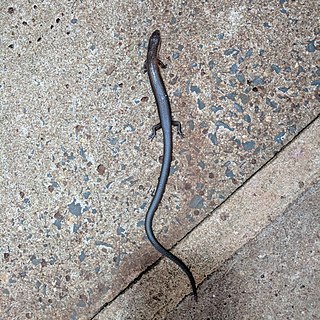
The International Union for Conservation of Nature (IUCN) Red List of Threatened Species, also known as the IUCN Red List or Red Data Book, founded in 1964, is an inventory of the global conservation status and extinction risk of biological species. A series of Regional Red Lists, which assess the risk of extinction to species within a political management unit, are also produced by countries and organizations.

Leptosiaphos is a genus of skinks endemic to West Africa.
Leptosiaphos koutoui is a species of skink, a lizard in the subfamily Eugongylinae of the family Scincidae. The species is endemic to Cameroon and is only known from the Adamaoua Massif near Meiganga.

Eugongylinae is a subfamily of skinks within the family Scincidae. The genera in this subfamily were previously found to belong the Eugongylus group in the large subfamily Lygosominae.

Leptosiaphos aloysiisabaudiae, the Uganda five-toed skink, is a species of lizard in the family Scincidae. The species is endemic to Sub-Saharan Africa.
Leptosiaphos amieti, also known commonly as the Cameroon five-toed skink, is a species of lizard in the family Scincidae. The species is endemic to Cameroon.
Leptosiaphos blochmanni, also known commonly as the Zaire three-toed skink, is a species of lizard in the family Scincidae. The species is native to Central Africa.
Leptosiaphos dewittei, also known commonly as De Witte's five-toed skink, De Witte's leaf-litter skink, and Witte's five-toed skink, is a species of lizard in the family Scincidae. The species is indigenous to Central Africa.
Leptosiaphos fuhni, Fuhn's five-toed skink, is a species of lizard in the family Scincidae. The species is endemic to Cameroon.
Leptosiaphos graueri, also known commonly as the Rwanda five-toed skink, is a species of lizard in the family Scincidae. The species is endemic to Africa.
Leptosiaphos hackarsi, also known commonly as Hackars' five toed skink or Hackars's five-toed skink, is an endangered species of lizard in the family Scincidae. The species is native to central Africa.
Leptosiaphos hylophilus, Laurenti's five-toed skink, is a species of lizard in the family Scincidae. It is found in Zaire.

Leptosiaphos kilimensis, commonly known as the Kilimanjaro five-toed skink, is a species of lizard in the family Scincidae. It is found in Kenya, Tanzania, and South Sudan.
Leptosiaphos luberoensis, Witte's five-toed skink, is a species of lizard in the family Scincidae. It is found in the Democratic Republic of the Congo.
Leptosiaphos meleagris, the Ruwenzori four-toed skink, is a species of lizard in the family Scincidae. It has been found in Uganda, Rwanda, the Democratic Republic of the Congo and Burundi.

Leptosiaphos pauliani is a species of lizard in the family Scincidae. It is found in Cameroon.

Leptosiaphos rhodurus, the red five-toed skink, is a species of lizard in the family Scincidae. It is found in the Democratic Republic of the Congo.
Leptosiaphos rhomboidalis, the Udzungwa five-toed skink, is a species of lizard in the family Scincidae. It is found in Tanzania.
Leptosiaphos vigintiserierum, also known as the African five-toed skink, is a species of lizard in the family Scincidae. It is found in Cameroon and Equatorial Guinea (Bioko).






